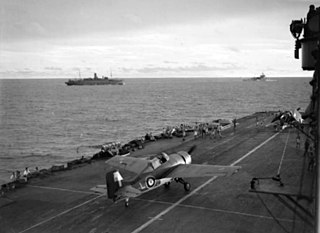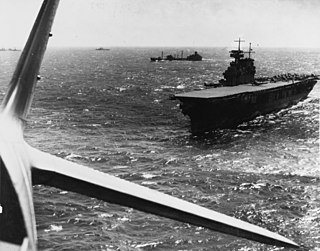Related Research Articles

An aircraft carrier is a warship that serves as a seagoing airbase, equipped with a full-length flight deck and facilities for carrying, arming, deploying, and recovering aircraft. Typically, it is the capital ship of a fleet, as it allows a naval force to project air power worldwide without depending on local bases for staging aircraft operations. Carriers have evolved since their inception in the early twentieth century from wooden vessels used to deploy balloons to nuclear-powered warships that carry numerous fighters, strike aircraft, helicopters, and other types of aircraft. While heavier aircraft such as fixed-wing gunships and bombers have been launched from aircraft carriers, it is currently not possible to land them. By its diplomatic and tactical power, its mobility, its autonomy and the variety of its means, the aircraft carrier is often the centerpiece of modern combat fleets. Tactically or even strategically, it replaced the battleship in the role of flagship of a fleet. One of its great advantages is that, by sailing in international waters, it does not interfere with any territorial sovereignty and thus obviates the need for overflight authorizations from third-party countries, reduces the times and transit distances of aircraft and therefore significantly increase the time of availability on the combat zone.

USS Enterprise (CVN-65), formerly CVA(N)-65, is a decommissioned United States Navy aircraft carrier. She was the first nuclear-powered aircraft carrier and the eighth United States naval vessel to bear the name. Like her predecessor of World War II fame, she is nicknamed "Big E". At 1,123 feet (342 m), she is the longest naval vessel ever built. Her 93,284-long-ton (94,781 t) displacement ranks her as the 12th-heaviest carrier, after the ten carriers of the Nimitz class and USS Gerald R. Ford. Enterprise had a crew of some 4,600 service members.

USS Oriskany (CV/CVA-34) – nicknamed Mighty O, and occasionally referred to as the O-boat – was one of the few Essex-class aircraft carriers completed after World War II for the United States Navy. The ship was named for the Battle of Oriskany during the Revolutionary War.

USS Constellation (CV-64), a Kitty Hawk-class supercarrier, was the third ship of the United States Navy to be named in honor of the "new constellation of stars" on the flag of the United States. One of the fastest ships in the Navy, as proven by her victory during a battlegroup race held in 1985, she was nicknamed "Connie" by her crew and officially as "America's Flagship".

USS Saratoga (CV/CVA/CVB-60), was the second of four Forrestal-class supercarriers built for the United States Navy in the 1950s. Saratoga was the sixth U.S. Navy ship, and the second aircraft carrier, to be named for the Battles of Saratoga in the American Revolutionary War.

Yankee Station was a fixed coordinate off the coast of Vietnam where U.S. Navy aircraft carriers and support ships loitered in open waters over a nine-year period during the Vietnam War. The location was used primarily by aircraft carriers of Task Force 77 to launch strikes over North Vietnam. While the coordinate's official designation was "Point Yankee", it was universally referred to as Yankee Station. Carriers conducting air operations at Yankee Station were said to be "on the line" and statistical summaries were based on days on the line. Yankee Station was initially located at 16° 00′ N, 110° 00′ E, however with a massive increase in operations over North Vietnam in 1966 the station was moved about 145 miles (230 km) northwest to 17° 30′ N, 108° 30′ E, placing it about 90 miles (145 km) from the North Vietnamese shore.
USS Ticonderoga (CV/CVA/CVS-14) was one of 24 Essex-class aircraft carriers built during World War II for the United States Navy. The ship was the fourth US Navy ship to bear the name, and was named after the capture of Fort Ticonderoga in the American Revolutionary War. Ticonderoga was commissioned in May 1944, and served in several campaigns in the Pacific Theater of Operations, earning five battle stars. Decommissioned shortly after the end of the war, she was modernized and recommissioned in the early 1950s as an attack carrier (CVA), and then eventually became an antisubmarine carrier (CVS). She was recommissioned too late to participate in the Korean War, but was very active in the Vietnam War, earning three Navy Unit Commendations, one Meritorious Unit Commendation, and 12 battle stars.

USS Hancock (CV/CVA-19) was one of 24 Essex-class aircraft carriers built during World War II for the United States Navy. The ship was the fourth US Navy ship to bear the name, and was named for John Hancock, president of the Second Continental Congress and first governor of the Commonwealth of Massachusetts. Hancock was commissioned in April 1944, and served in several campaigns in the Pacific Theater of Operations, earning four battle stars. Decommissioned shortly after the end of the war, she was modernized and recommissioned in the early 1950s as an attack carrier (CVA). In her second career she operated exclusively in the Pacific, playing a prominent role in the Vietnam War, for which she earned a Navy Unit Commendation. She was the first US Navy carrier to have steam catapults installed.

USS America (CVA/CV-66) was one of three Kitty Hawk-class supercarriers built for the United States Navy in the 1960s. Commissioned in 1965, she spent most of her career in the Atlantic and Mediterranean, but did make three Pacific deployments serving in the Vietnam War. She also served in the Persian Gulf War's operations Desert Shield and Desert Storm.

The seventh USS Ranger (CV/CVA-61) was the third of four Forrestal-class supercarriers built for the United States Navy in the 1950s. Although all four ships of the class were completed with angled decks, Ranger had the distinction of being the first US carrier built from the beginning as an angled-deck ship.

USS Valley Forge was one of 24 Essex-class aircraft carriers built during and shortly after World War II for the United States Navy. The ship was the first US Navy ship to bear the name, and was named after Valley Forge, the 1777–1778 winter encampment of General George Washington's Continental Army. Valley Forge was commissioned in November 1946, too late to serve in World War II, but saw extensive service in the Korean War and the Vietnam War. She was reclassified in the early 1950s as an attack carrier (CVA), then to an antisubmarine carrier (CVS), and finally to an amphibious assault ship (LPH), carrying helicopters and Marines. As a CVS she served in the Atlantic and Caribbean. She was the prime recovery vessel for an early unmanned Mercury space mission. After conversion to an LPH she served extensively in the Vietnam War. Valley Forge was awarded eight battle stars for Korean War service and nine for Vietnam War service, as well as three Navy Unit Commendations.

USS Midway (CVB/CVA/CV-41) is an aircraft carrier, formerly of the United States Navy, the lead ship of her class. Commissioned 8 days after the end of World War II, Midway was the largest ship in the world until 1955, as well as the first U.S. aircraft carrier too big to transit the Panama Canal. She operated for 47 years, during which time she saw action in the Vietnam War and served as the Persian Gulf flagship in 1991's Operation Desert Storm. Decommissioned in 1992, she is now a museum ship at the USS Midway Museum, in San Diego, California, and is the only remaining inactive U.S. aircraft carrier that is not an Essex-class aircraft carrier.

Strike Fighter Squadron 113 (VFA-113), also known as the "Stingers," is a United States Navy strike fighter squadron based at Naval Air Station Lemoore, California. They are an operational fleet F/A-18E Super Hornet squadron attached to Carrier Air Wing 2 (CVW-2) and based at NAS Lemoore, California. Their tailcode is NE and their radio callsign is Sting.

Carrier Air Wing Two (CVW-2) is a United States Navy aircraft carrier air wing based at Naval Air Station Lemoore. The air wing is attached to the aircraft carrier USS Carl Vinson (CVN-70).

Modern United States Navy aircraft carrier air operations include the operation of fixed-wing and rotary aircraft on and around an aircraft carrier for performance of combat or noncombat missions. The flight operations are highly evolved, based on experiences dating back to 1922 with USS Langley.

Attack Squadron 46 was an attack squadron of the United States Navy that was active during the Cold War. VA-46 was deactivated as part of the post-Cold War drawdown of forces on 30 June 1991.

Aircraft carriers are warships that evolved from balloon-carrying wooden vessels into nuclear-powered vessels carrying scores of fixed- and rotary-wing aircraft. Since their introduction they have allowed naval forces to project air power great distances without having to depend on local bases for staging aircraft operations.

Aircraft carrier air operations include a launch and recovery cycle of embarked aircraft. Launch and recovery cycles are scheduled to support efficient use of naval aircraft for searching, defensive patrols, and offensive airstrikes. The relative importance of these three missions varies with time and location. Through the first quarter-century of aircraft carrier operations, launch and recovery cycles attempted to optimize mission performance for ships with a straight flight deck above an aircraft storage hangar deck. Carrier air operations evolved rapidly from experimental ships of the early 1920s through the combat experience of World War II.

VA-55 was an Attack Squadron of the U.S. Navy. It was established as Torpedo Squadron VT-5 on 15 February 1943, redesignated VA-6A on 15 November 1946, and finally designated VA-55 on 16 August 1948. The squadron was disestablished on 12 December 1975. It was the first squadron to be designated VA-55, the second VA-55 was established on 7 October 1983 and disestablished on 1 January 1991.

Attack Squadron 145 (VA-145) was an aviation unit of the United States Navy, nicknamed the Rustlers from 1951-1954, and the Swordsmen thereafter. The squadron was established as Reserve squadron VA-702 on 1 December 1949, and called to active duty on 20 July 1950. It was redesignated VA-145 on 4 February 1953, and disestablished on 1 October 1993.
References
- ↑ Tactical Command and Control of Carrier Operations, Admiral James L. Holloway III, USN (Ret.)